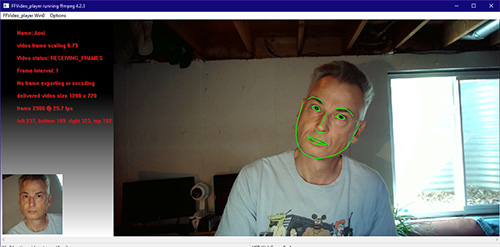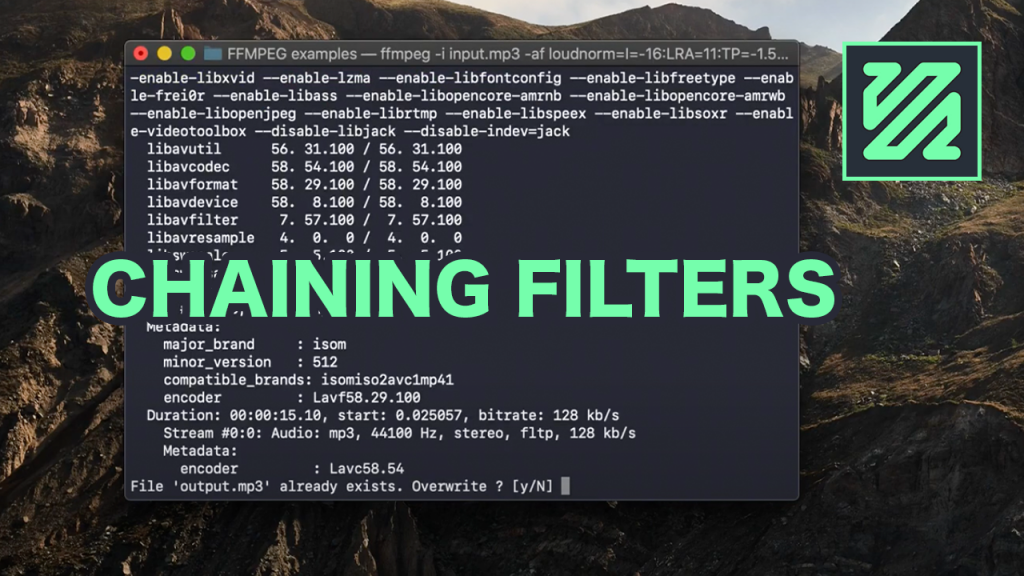

ffmpeg -y -i input.mkv \ -filter_complex "format=yuv420p,yadif,split=3 scale=1920:1080 scale=720:576,hflip fps=1/5,scale=320:180 aresample=48000,asplit=2" \ -map -map hd.mov \ -map -map sd-flipped.mp4 \ -map thumbnail-%03d.jpgĪs shown above, we apply the common operations early in the graph and try to reuse the filters whenever possible. In this final example, we try to reuse common filters and produce simultaneous outputs in parallel. Lastly, we map ch1 and ch2 to produce two separate WAV files. The first pan filter will select the first channel ( c0) from a1 and the second one will select the second channel ( c1)from a2, and we label the outputs from these pan filters ch1 and ch2 respectively. Then we connect each of these to pan filters that are each set up to produce one mono channel. We first fork the input audio with the asplit filter into two identical branches labeled a1 and a2. Getting slightly complicated now, but the graph image above should make it easier to understand. Extract audio channels ffmpeg -y -i input.mxf \ -filter_complex "asplit=2 pan=mono|c0=c0 pan=mono|c0=c1" \ -map channel_1.wav \ -map channel_2.wav We scale it to required dimensions and give a pattern for the thumbnail filename to be numbered as we like. The fps filter is used here to say that we need 1 frame every 5 seconds.

Thumbnails at interval ffmpeg -y -i input.mp4 -filter_complex "fps=1/5,scale=320:180" thumbnail-%03d.jpg jpg extension, and -vframes 1 will tell FFmpeg to produce a single image at the specified time instance. Snapshot at time ffmpeg -y -i input.mkv -ss 2.598 -vframes 1 output.jpg Here, -ss and -to are used to specify the start and end times in seconds. Clipping ffmpeg -y -i input.mkv -ss 30.4 -to 40.15 output.mp4 Here we are using the scale filter and specifying the output width and height. Filters sit between the input and the output and make some change to the media flowing through them. filter_complex can be used to combine many filters together. Resize the video ffmpeg -y -i input.mkv -filter_complex scale=720:480 output.mp4 map 0:v selects the video streams from the first input (we have only one input file here anyway, marked by 0), while 0:a means the audio streams. Take only video or audio ffmpeg -y -i input.mkv -map 0:v output.mp4 Here, we specify the video and audio codecs with -vcodec and -acodec. It is common to use FFmpeg to transcode from one codec to another. Codec conversion ffmpeg -y -i input.mkv -vcodec libx264 -acodec flac output.mkv In addition to these two, FFmpeg supports many other popular multimedia file formats, including MXF, AVI, WAV, M4A, JPG, PNG etc. y denotes that we want to overwrite output.mp4 if it already exists.
FFMPEG FILTERS EXAMPLE MP4
In this simplest example, FFmpeg produces MP4 output from MKV input. (Since humans are sensitive to luminance components, in most cases, it is the idea that only processing luminance components suffices.Format conversion ffmpeg -y -i input.mkv output.mp4 Only the luminance component is processed. This example is the same as that in the official document.

If you can not understand the way of thinking in the frequency domain, use “avgblur” etc. Even so, of course, easiness to understand of dedicated blur filters is much larger than this filter. Just like “convolution” you can also use the generic filter “fftfilt” for blurring purposes.Īs the name suggests, this filter allows you to apply arbitrary expressions to samples in frequency domain.Īs with “convolution”, understanding and familiarity with mathematics or image processing is also necessary for use of this, I personally think that thinking in the frequency domain is intuitive, so blurring control by this filter may be easier than “convolution”.


 0 kommentar(er)
0 kommentar(er)
